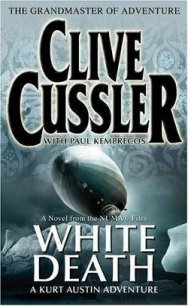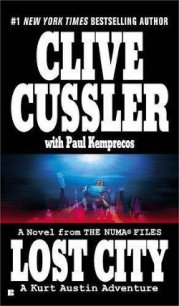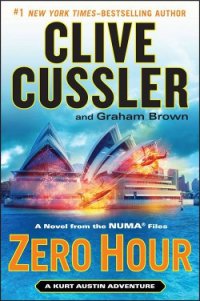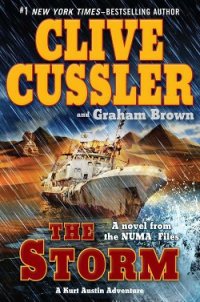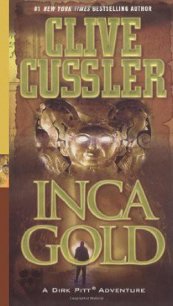The Navigator - Cussler Clive (читаем книги онлайн бесплатно полностью .TXT) 📗
His benefactor’s mellifluous voice came on the phone immediately.
“I’ve been waiting for your call, Adriano,” he said.
“Sorry for the delay, sir. There were unexpected difficulties.”
Adriano described every detail of his encounter with Ali. His benefactor would know if he were lying or shading the truth.
“I’m very disappointed, Adriano.”
“I know, sir. I was under orders not to let the Navigator fall into anyone else’s hands. This seemed to be the only way.”
“You were absolutely right to follow orders. It is important that we find the object first. We have waited nearly three thousand years. A little more time won’t matter.”
Adriano breathed a sigh of relief. He had been trained not to feel pain or fear, but he was well aware of the fate of those who displeased his benefactor. “Do you want me to try to track it down?”
“No. I’ll try to go through international channels once more. It’s becoming too dangerous there for you.”
“I’ve made arrangements to leave the country through Syria.”
“Good.” There was a pause at the other end of the line. “This woman, Carina Mechadi, may prove useful.”
“In what way, sir?”
“We shall see, Adriano. We shall see.”
The line went dead.
He grabbed his bag and closed the hotel-room door behind him. He planned to meet an oil smuggler who had promised to get him out of Iraq. In accordance with his standing orders to leave no trace of his passing, he would, of course, dispatch the man to Allah once he was safe across the border.
He smiled as he savored the prospect.
Chapter 4
FAIRFAX COUNTY, VIRGINIA, THE PRESENT
THE RED CORVETTE CONVERTIBLE swung off the road, with its stereo speakers blasting salsa music like a Tijuana jukebox on wheels. The car breezed along a driveway that ran past a Victorian mansion and lawns which looked as if they had been clipped with manicure scissors. Joe Zavala pulled his car up in front of an ornate boathouse built on the banks of the Potomac River and was about to slide out from behind the steering wheel when he heard the gunshot.
As a brilliant designer of undersea craft for the National Underwater and Marine Agency, Zavala ordinarily carried nothing more lethal than a laptop computer. But his years working for NUMA’s Special Assignments Team had taught him the wisdom of the Boy Scout adage to be prepared. Zavala reached under the car seat, his fingers closed on a quick-release holster, and his hand came out with a Walther PPK handgun.
He got out of the car and made his way around the boathouse, moving with the stealth of a deer hunter. Pressing his back to the exterior wall, he edged his way to the corner and popped out into the open, gun extended with both hands and ready to find a target.
A broad-shouldered man dressed in tan shorts and white T-shirt was standing on the riverbank with his back to Zavala. The man held a pistol down by his thigh and was inspecting a paper bull’s-eye pinned to a tree. A cloud of purple smoke hung in the air. The man slipped a pair of ear protectors off his head just as Zavala stepped on a twig. He turned at the snapping sound and saw Zavala creeping around the corner with the gun clutched in his hands.
Kurt Austin, Zavala’s boss on NUMA’s Special Assignments Team, grinned and said, “Going on a turkey shoot, Joe?”
Zavala lowered the gun and walked over to the tree to inspect the hole that had been punched slightly off the center ring of the target.
“You’re the one who should be hunting turkeys, deadeye.”
Austin removed his yellow protective shooting goggles to reveal blue eyes the color of coral under water. “I’ll stick to stationary targets for now.” He glanced at Zavala’s pistol. “What’s with the SWAT team imitation?”
Zavala tucked the gun into his belt. “You didn’t tell me you’d turned your expensive riverfront property into a shooting gallery.”
Austin blew the smoke away from the pistol barrel like a gun-fighter who’d beaten his opponent to the draw.
“I couldn’t wait to try out my new toy at a shooting range.”
He handed the flintlock dueling pistol to Zavala, who inspected the walnut stock and the engraved octagonal barrel.
“Nice balance,” he said, hefting the weapon. “How old is it?”
“It was made in 1785 by Robert Wogdon, a London gunsmith. He fashioned some of the most accurate dueling pistols of his day. You test a dueling pistol by dangling it down at arm’s length. Then you bring it up quickly and hold it just long enough to check the sights and squeeze off a shot. It should be right on target.”
Zavala aimed for another tree and clicked his tongue to simulate gunfire.
“Bull’s-eye,” Austin said.
Zavala handed the pistol back. “Didn’t you tell me your pistol collection was complete?”
“Blame it on Rudi,” Austin said with a shrug. Rudi Gunn was the assistant director of NUMA.
“All he said was to decompress after our last assignment,” Zavala said.
“You make my case. Idle time is a dangerous thing in the hands of a collector.” Austin ripped the target off the tree and tucked it into his pocket. “What brings you to Virginia? Run out of women to date in Washington?”
Zavala’s quiet-spoken charm and dark good looks made him much in demand on the Washington dating scene. The corners of his mouth turned up slightly in his trademark smile.
“I won’t say I’ve been living a monk’s life because you’d never believe me. I stopped by to show you a project I started months ago.”
“Project S? You can fill me in while we work on a couple of beers,” Austin said.
He put the shooting gear in a bag, wrapped the pistol in a soft cloth, and led the way up a staircase to a wide deck that overlooked the river.
Austin had bought the boathouse near Langley when he was with a clandestine undersea unit of the CIA. The purchase was beyond his budget, but the panoramic view of the river had closed the deal, and he got the price down because the boathouse was a wreck. He had spent thousands of dollars and countless hours transforming it from a run-down repository for boats to a comfortable retreat from the demands of his job as director of the Special Assignments Team.
Austin got couple of cold Tecate beers from the refrigerator, went out to the deck and handed one to Zavala. They clinked bottles and took a swig of the Mexican brew. Zavala took a sheet of computer paper from his pocket, placed it on a table, and smoothed out the folds with his hand.
“What do you think of my new wet submersible?”
In a wet submersible, the pilot and passenger wore scuba gear and sat on the outside of the vehicle rather than inside an enclosed cockpit. Wet submersibles commonly echoed the shape of their dry counterparts, with propellers at one end of a torpedo-shaped vehicle, the pilot at the other end.
The vehicle that Zavala had designed had a long, sloping hood, tapering trunk, and a wraparound windshield. It had dual headlights, white, so-called cove panels on the side, and a two-toned interior. The submersible had four thrusters instead of wheels.
Austin cleared his throat. “If I didn’t know this was a submersible, I’d swear it looked like a 1961 Corvette. Your ’Vette, in fact.”
Zavala pinched his chin between his thumb and forefinger. “This is turquoise. My car is red.”
“She looks fast,” Austin said appraisingly.
“My car can do zero to sixty in about six seconds. This is a little slower. But she’ll move out on or under the water and handles the curves as if they weren’t there. She’ll do everything a car can do except peel rubber.”
“Why the departure from more, uh, conventional submersible models, like the saucer, torpedo, or bulbous shape?”
“Apart from the challenge, I wanted something I could use on NUMA assignments that would be fun to drive.”
“Will this thing work?”
